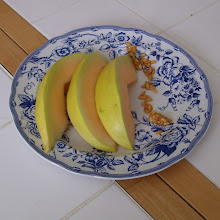What’s So Significant About 64 Variations?
The Ciaccona has 64 variations, and I immediately called that evidence of Bach’s larger, impressive structure for the Ciaccona. What’s so important about the number 64?
Musical phrases usually come in groups of four or eight measures, and they certainly did so in 1720’s German music. The Ciaccona is based on both threes and fours. Each measure of the Ciaccona has three beats, and each has four measures. That’s common for pieces in three (think of your favorite waltz). And though each measure has three beats, each quarter-note beat is evenly divided into eighth notes, sixteenth notes, and thirty-second notes, in all but two variations – not divided into triplets, as it could be.
The fact that beats are evenly divided into halves, quarters, eighths, sixteenths, and thirty-seconds means that those powers of two are particularly relevant numbers. They are more relevant than just any multiple of two, such as 60, or even just any multiple of 16, like 96.
Bach could have just aspired to write a large number of variations and stopped anywhere after fifty. 51. 52. 60. Why 64 variations? To start, it’s an even number. There’s nothing significant about the number of variations being even. Of course, there’s a fifty-percent chance of that. But there is something significant about the number of variations being 64. Having the number of variations be a power of two, in this case, two to the sixth power, would allow the entire piece to be evenly subdivided six times (32, 16, 8, 4, 2, 1). That’s not true for other numbers. Take the number 60. 60 is a multiple of 4. Do I think that would be amazing, too? 60 variations could only be evenly divided twice (30, 15). Sets of 15 variations, or musical units, would be unusual for traditional, European music, because this piece is based on threes and fours, not fives.
Though having 64 variations would allow the piece to be neatly subdivided multiple times, it isn’t. The piece has three sections, each one shorter than the previous, and that don’t have tidy numbers of variations. The first section, in D-minor, is 33 variations long. It’s followed by an 19-variation major section, then by a 12-variation minor section.
Analyzing the larger structure of the Ciaccona is a large task that others have tried to tackle. I think that they mostly end up speculating about why Bach organized it the way he did. Here’s my speculation.
The opening theme recurs more and more frequently throughout the Ciaccona. I may be influenced by Arnold Steinhardt (whose book, Violin Dreams, I just finished) when I say that the opening theme reminds me of the call of death, the call for the end of the partita. The Ciaccona begins by saying, “It’s time to end the partita,” then, its whole life flashes before its eyes, but in the end, the Ciaccona theme keeps coming back more and more frequently until the end of the movement. It’s like in stories where death is a shrouded figure you sometimes see and worry about, then say, “Oh, it’s nothing.” Then the figure comes back. In the middle section, in D major, you think that you’ve escaped the end of the Ciaccona and that it’s going to keep going forever. Then the opening theme comes back, and the last section is the shortest of them all. I think it’s the way childhood seems to last forever, but then life speeds up during middle age, and before you know it, it’s gone.


